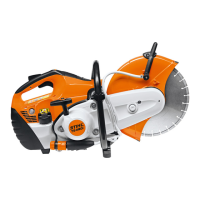TS 480i, TS 500i
English
9
Fuel Filler Cap
Never use a tool to open or close the fuel
filler cap, as this could damage the cap
and cause fuel leakage or spillage.
The fuel filler cap must be securely
closed after refuelling.
WARNING
Never attempt to force the fuel cap open
by using a tool. It may damage the cap
and allow fuel to leak.
WARNING
Before use, make sure that the fuel cap
has been securely and properly installed
and any spilled fuel wiped away. Check
for fuel leakage while refueling and
during operation. If a fuel leak is
suspected, do not start or run the
machine until the leak is fixed and all
leaked fuel has been wiped away.
Before Starting
For wheel installation, follow the
procedure described in the chapter
"Mounting an Abrasive Cutting Wheel" in
this instruction manual.
WARNING
Check the fuel system for leaks,
especially the visible parts, e.g., fuel
tank, filler cap, hose connections and
manual fuel pump. To reduce the risk of
personal injury or property damage from
fire, do not start the engine if there are
fuel leaks or the fuel system is damaged.
Have the machine repaired by an
authorized STIHL servicing dealer
before using it.
WARNING
Never operate a cut-off machine if it is
damaged, improperly adjusted or
maintained, or not completely and
properly assembled. Check that the
machine is ready for safe operation.
Keep the handles dry, clean and free of
oil and fuel.
WARNING
Before operation of your cut-off
machine, be sure the controls (e.g.
throttle trigger, throttle trigger lockout,
stop switch) and the safety devices are
working properly, the wheel is properly
mounted, and the wheel guard is
properly positioned and securely
fastened to your unit. All wheels should
be carefully inspected for damage
before mounting. Never mount or use an
abrasive cutting wheel that is cracked or
otherwise damaged.
WARNING
Check that the spark plug boot is
securely mounted on the spark plug – a
loose boot may cause arcing that could
ignite combustible fumes or spilled fuel
and cause a fire.
Proper tensioning of the ribbed V-belt is
important. In order to avoid an incorrect
setting, the tensioning procedure must
be followed as described in the chapter
"Tensioning the ribbed V-belt" in this
manual. Always make sure the
hexagonal collar nuts for the cast arm
are tightened securely.
Check ribbed belt tension after one hour
of operation and correct if necessary.
Adjust the wheel guard
so that sparks, dust and
cut material are deflected
away from the operator,
and cannot reach flam-
mable surroundings or
materials. See the sec-
tion "Operating
Instructions" in this
instruction manual. Never
direct sparks or cutting
debris toward flammable
materials or toward the
operator.

